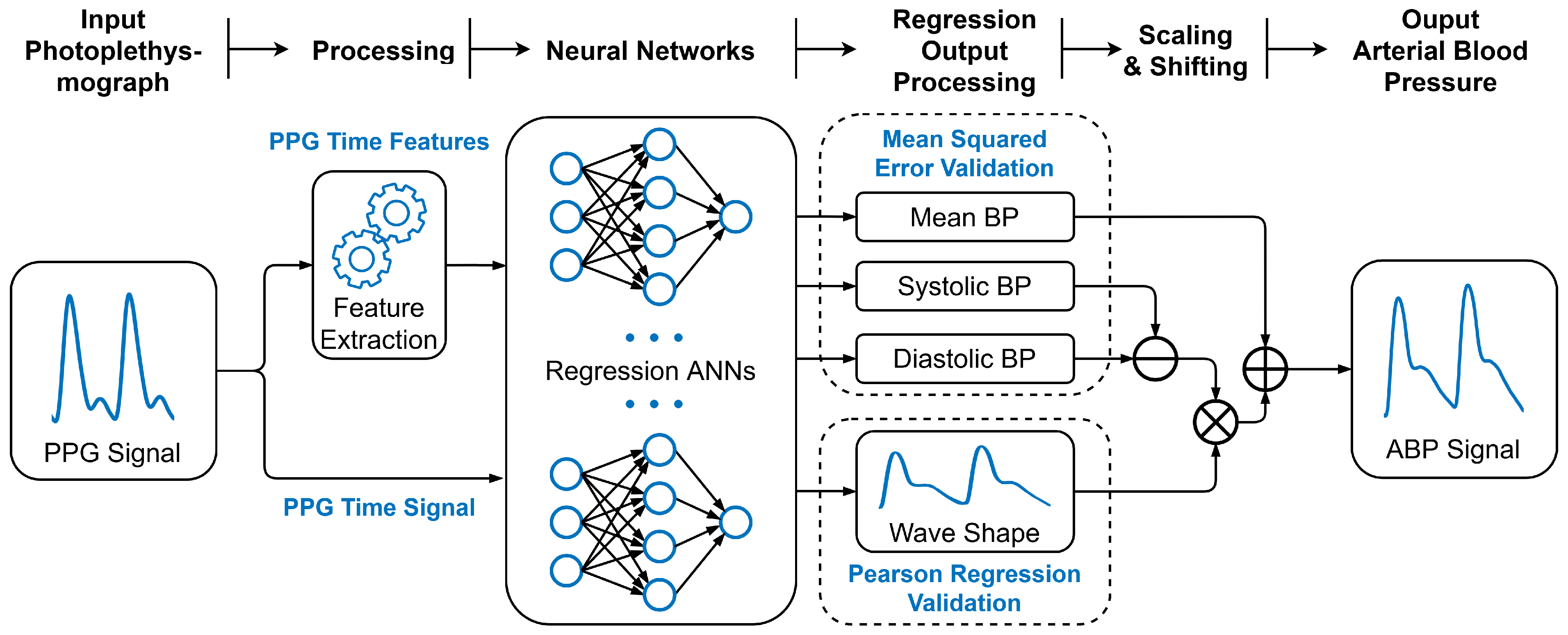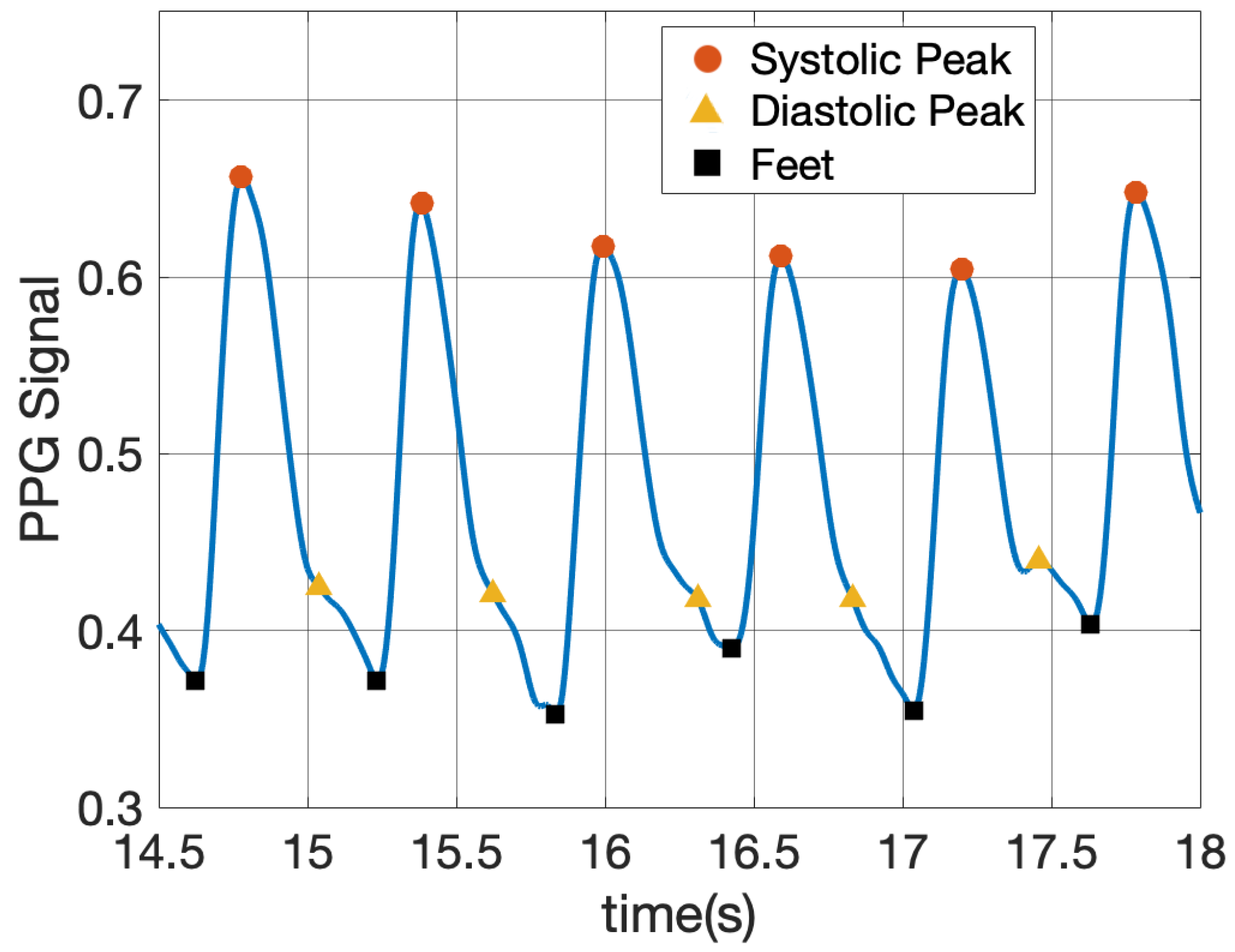A Machine Learning Approach to the Non-Invasive Estimation of Continuous Blood Pressure Using Photoplethysmography
Abstract
:1. Introduction
2. Background
3. Materials and Methods
3.1. Dataset Description
3.2. Data Processing
3.3. Machine Learning Approach
3.4. Discrete Blood Pressure Prediction
3.4.1. Feature Extraction
- Time-related features: systolic upstroke duration, diastolic duration, and duration between systolic peak and diastolic peak.
- Amplitude-features: systolic peak, diastolic peak, foot, augmentation index (ratio of systolic peak-to-diastolic peak).
- Time and amplitude features: systolic width, diastolic width, total width (sum of the systolic and diastolic widths), ratio of systolic to diastolic widths.
- Area features: pulse area (total area under PPG curve over a cardiac cycle), inflection point area (ratio of area post dicrotic notch to area pre-dicrotic notch).
- Frequency-features: respiratory rate, heart rate.
3.4.2. Models
3.5. Waveform Prediction
3.5.1. Processing
3.5.2. Regression Loss Layer
3.5.3. Machine Learning Models
3.6. Testing
4. Results
5. Discussion
5.1. Significance of Results
5.2. Recommendations for Further Work
6. Conclusions
Author Contributions
Funding
Institutional Review Board Statement
Informed Consent Statement
Data Availability Statement
Acknowledgments
Conflicts of Interest
Abbreviations
| ABP | Arterial Blood Pressure |
| ANN | Artificial Neural Network |
| CNN | Convolutional Neural Network |
| DBP | Diastolic Blood Pressure |
| LSTM | Long Short Term Memory |
| MAP | Mean Arterial Pressure |
| PPG | Photoplethysmography |
| SBP | Systolic Blood Pressure |
References
- Rehman, S.; Nelson, V.L. Blood Pressure Measurement, 2021. Available online: https://www.ncbi.nlm.nih.gov/books/NBK482189/ (accessed on 19 October 2021).
- Pittman, J.A.L.; Ping, J.S.; Mark, J.B. Arterial and central venous pressure monitoring. Int. Anesthesiol. Clin. 2004, 42, 13–30. [Google Scholar] [CrossRef] [PubMed]
- Denardo, S.J.; Nandyala, R.; Freeman, G.L.; Pierce, G.L.; Nichols, W.W. Pulse Wave Analysis of the Aortic Pressure Waveform in Severe Left Ventricular Systolic Dysfunction. Circ. Heart Fail. 2009, 3, 149–156. [Google Scholar] [CrossRef] [PubMed] [Green Version]
- Hager, H.H.; Burns, B. Artery Cannulation, 2021. Available online: https://www.ncbi.nlm.nih.gov/books/NBK482242/ (accessed on 19 October 2021).
- Elgendi, M. On the Analysis of Fingertip Photoplethysmogram Signals. Curr. Cardiol. Rev. 2012, 8, 14–25. [Google Scholar] [CrossRef] [PubMed]
- Wang, R.; Jia, W.; Mao, Z.H.; Sclabassi, R.J.; Sun, M. Cuff-free blood pressure estimation using pulse transit time and heart rate. In Proceedings of the 2014 12th International Conference on Signal Processing (ICSP), Hangzhou, China, 19–23 October 2014; pp. 115–118. [Google Scholar] [CrossRef] [Green Version]
- Kurylyak, Y.; Lamonaca, F.; Grimaldi, D. A Neural Network-based method for continuous blood pressure estimation from a PPG signal. In Proceedings of the 2013 IEEE International Instrumentation and Measurement Technology Conference (I2MTC), Minneapolis, MN, USA, 6–9 May 2013; pp. 280–283. [Google Scholar] [CrossRef]
- Chowdhury, M.H.; Shuzan, M.N.I.; Chowdhury, M.E.; Mahbub, Z.B.; Uddin, M.M.; Khandakar, A.; Reaz, M.B.I. Estimating Blood Pressure from the Photoplethysmogram Signal and Demographic Features Using Machine Learning Techniques. Sensors 2020, 20, 3127. [Google Scholar] [CrossRef] [PubMed]
- Teng, X.; Zhang, Y. Continuous and noninvasive estimation of arterial blood pressure using a photoplethysmographic approach. In Proceedings of the 25th Annual International Conference of the IEEE Engineering in Medicine and Biology Society (IEEE Cat. No.03CH37439), Cancun, Mexico, 17–21 September 2003; Volume 4, pp. 3153–3156. [Google Scholar] [CrossRef]
- Yoon, Y.Z.; Yoon, G.W. Nonconstrained Blood Pressure Measurement by Photoplethysmography. J. Opt. Soc. Korea 2006, 10, 91–95. [Google Scholar] [CrossRef] [Green Version]
- Paviglianiti, A.; Randazzo, V.; Villata, S.; Cirrincione, G.; Pasero, E. A Comparison of Deep Learning Techniques for Arterial Blood Pressure Prediction. Cogn. Comput. 2021, 14, 1689–1710. [Google Scholar] [CrossRef] [PubMed]
- Athaya, T.; Choi, S. An Estimation Method of Continuous Non-Invasive Arterial Blood Pressure Waveform Using Photoplethysmography: A U-Net Architecture-Based Approach. Sensors 2021, 21, 1867. [Google Scholar] [CrossRef] [PubMed]
- El-Hajj, C.; Kyriacou, P.A. A review of machine learning techniques in photoplethysmography for the non-invasive cuff-less measurement of blood pressure. Biomed. Signal Process. Control 2020, 58, 101870. [Google Scholar] [CrossRef]
- Slapničar, G.; Mlakar, N.; Luštrek, M. Blood Pressure Estimation from Photoplethysmogram Using a Spectro-Temporal Deep Neural Network. Sensors 2019, 19, 3420. [Google Scholar] [CrossRef] [PubMed] [Green Version]
- Stergiou, G.S.; Alpert, B.; Mieke, S.; Asmar, R.; Atkins, N.; Eckert, S.; Frick, G.; Friedman, B.; Graßl, T.; Ichikawa, T.; et al. A Universal Standard for the Validation of Blood Pressure Measuring Devices: Association for the Advancement of Medical Instrumentation/European Society of Hypertension/International Organization for Standardization (AAMI/ESH/ISO) Collaboration Statement. Hypertension 2018, 71, 368–374. [Google Scholar] [CrossRef] [PubMed]
- Moody, B.; Moody, G.; Villarroel, M.; Clifford, G.; Silva, I. MIMIC-III Waveform Database (version 1.0). PhysioNet 2020, 3. [Google Scholar] [CrossRef]
- Johnson, A.; Pollard, T.; Shen, L.; Lehman, L.; Feng, M.; Ghassemi, M.; Moody, B.; Szolovits, P.; Celi, L.; Mark, R. MIMIC-III, a freely accessible critical care database. Sci. Data 2016, 3, 160035. [Google Scholar] [CrossRef] [PubMed] [Green Version]
- Goldberger, A.; Amaral, L.; Glass, L.; Hausdorff, J.; Ivanov, P.; Mark, R.; Stanley, H. PhysioBank, PhysioToolkit, and PhysioNet: Components of a new research resource for complex physiologic signals. Circulation 2000, 101, 215–220. [Google Scholar] [CrossRef] [PubMed] [Green Version]
- PhysioNet. Open Data Commons Open Database License v1.0. Available online: https://physionet.org/content/mimic3wdb/view-license/1.0/ (accessed on 21 February 2023).
- Johnson, A.; Pollard, T.; Mark, R. MIMIC-III Clinical Database (version 1.4). PhysioNet 2016. [Google Scholar] [CrossRef]
- PhysioNet. The WFDB Software Package. Available online: https://archive.physionet.org/physiotools/wfdb.shtml#intro (accessed on 25 October 2012).
- Harfiya, L.N.; Chang, C.C.; Li, Y.H. Continuous Blood Pressure Estimation Using Exclusively Photopletysmography by LSTM-Based Signal-to-Signal Translation. Sensors 2021, 21, 2952. [Google Scholar] [CrossRef] [PubMed]
- Freedman, D.; Pisani, R.; Purves, R. Statistics (International Student Edition), 4th ed.; WW Norton & Company: New York, NY, USA, 2007. [Google Scholar]
- Addison, P.S.; Watson, J.N.; Mestek, M.L.; Mecca, R.S. Developing an algorithm for pulse oximetry derived respiratory rate (RRoxi): A healthy volunteer study. J. Clin. Monit. Comput. 2012, 26, 45–51. [Google Scholar] [CrossRef] [PubMed] [Green Version]
- Wang, Z.; Yan, W.; Oates, T. Time Series Classification from Scratch with Deep Neural Networks: A Strong Baseline. In Proceedings of the 2017 International Joint Conference on Neural Networks (IJCNN), Anchorage, AK, USA, 14–19 May 2017; pp. 1578–1585. [Google Scholar]
- Srivastava, N.; Hinton, G.; Krizhevsky, A.; Sutskever, I.; Salakhutdinov, R. Dropout: A Simple Way to Prevent Neural Networks from Overfitting. J. Mach. Learn. Res. 2014, 15, 1929–1958. [Google Scholar]
- Chicco, D.; Warrens, M.J.; Jurman, G. The coefficient of determination R-squared is more informative than SMAPE, MAE, MAPE, MSE and RMSE in regression analysis evaluation. PeerJ Comput. Sci. 2021, 7, e623. [Google Scholar] [CrossRef] [PubMed]





| # | Description |
|---|---|
| 1 | 3 fully connected 1024 layers with batch normalisation, ReLU, and 0.2 dropout, using Pearson correlation regression layer |
| 2 | 2 layers with 1024 bilstm units, with 0.2 dropout factors, with a standard regression layer |
| 3 | 2 layers with 1024 bilstm units, with 0.2 dropout factors solved using the Adam optimiser, with a standard regression layer |
| 4 | 2 layers with 1024 bilstm units, with 0.2 dropout factors, using the Pearson correlation regression layer |
| 5 | 2 layers with 1024 lstm units, with 0.2 dropout factors, using a standard regression layer |
| 6 | 2 layers with 1024 lstm units, with 0.2 dropout factors, using the Pearson correlation regression layer |
| Model | SBP | DBP | MAP | |||||||
|---|---|---|---|---|---|---|---|---|---|---|
| MAE | % Error | MAE | % Error | MAE | % Error | |||||
| <10 mmHg | <10 mmHg | <10 mmHg | ||||||||
| ANN (2 × 512) | 14.0 | 46.5 | 0.110 | 6.62 | 79.4 | 0.158 | 7.34 | 72.9 | 0.250 | |
| Full | ANN (3 × 512) | 13.8 | 47.3 | 0.148 | 6.54 | 80.0 | 0.158 | 7.16 | 74.3 | 0.274 |
| Waveform | LSTM | 22.5 | 27.1 | −0.819 | 22.2 | 10.1 | −0.0513 | 9.24 | 60.3 | −0.0754 |
| CNN | 16.1 | 35.8 | 0.00 | 21.6 | 10.7 | 0.00 | 8.79 | 62.4 | 0.00 | |
| ANN (2 × 512) | 5.73 | 83.7 | 0.777 | 2.96 | 95.8 | 0.692 | 3.27 | 94.5 | 0.771 | |
| Feature | ANN (3 × 512) | 5.32 | 86.5 | 0.780 | 3.50 | 94.9 | 0.614 | 3.65 | 94.2 | 0.750 |
| Extraction | ANN (4 × 512) | 5.26 | 86.1 | 0.798 | 3.39 | 94.9 | 0.629 | 3.30 | 94.1 | 0.745 |
| Binary Tree | 7.46 | 77.0 | 0.485 | 3.58 | 90.2 | 0.404 | 4.27 | 86.7 | 0.477 | |
| Reg. SVM | 13.8 | 44.4 | −0.769 | 6.11 | 84.5 | 0.0779 | 7.13 | 74.9 | 0.186 | |
| # | Structure | Regression | r |
|---|---|---|---|
| 1 | 3 × fc(1024) | Pearson | 0.864 |
| 2 | 2 × bilstm(1024) | Standard | 0.801 |
| 3 | 2 × bilstm(1024) 1 | Standard | 0.797 |
| 4 | 2 × bilstm(1024) | Pearson | 0.802 |
| 5 | 2 × lstm(1024) | Standard | 0.781 |
| 6 | 2 × lstm(1024) | Pearson | 0.818 |
Disclaimer/Publisher’s Note: The statements, opinions and data contained in all publications are solely those of the individual author(s) and contributor(s) and not of MDPI and/or the editor(s). MDPI and/or the editor(s) disclaim responsibility for any injury to people or property resulting from any ideas, methods, instructions or products referred to in the content. |
© 2023 by the authors. Licensee MDPI, Basel, Switzerland. This article is an open access article distributed under the terms and conditions of the Creative Commons Attribution (CC BY) license (https://creativecommons.org/licenses/by/4.0/).
Share and Cite
Tarifi, B.; Fainman, A.; Pantanowitz, A.; Rubin, D.M. A Machine Learning Approach to the Non-Invasive Estimation of Continuous Blood Pressure Using Photoplethysmography. Appl. Sci. 2023, 13, 3955. https://doi.org/10.3390/app13063955
Tarifi B, Fainman A, Pantanowitz A, Rubin DM. A Machine Learning Approach to the Non-Invasive Estimation of Continuous Blood Pressure Using Photoplethysmography. Applied Sciences. 2023; 13(6):3955. https://doi.org/10.3390/app13063955
Chicago/Turabian StyleTarifi, Basheq, Aaron Fainman, Adam Pantanowitz, and David M. Rubin. 2023. "A Machine Learning Approach to the Non-Invasive Estimation of Continuous Blood Pressure Using Photoplethysmography" Applied Sciences 13, no. 6: 3955. https://doi.org/10.3390/app13063955





